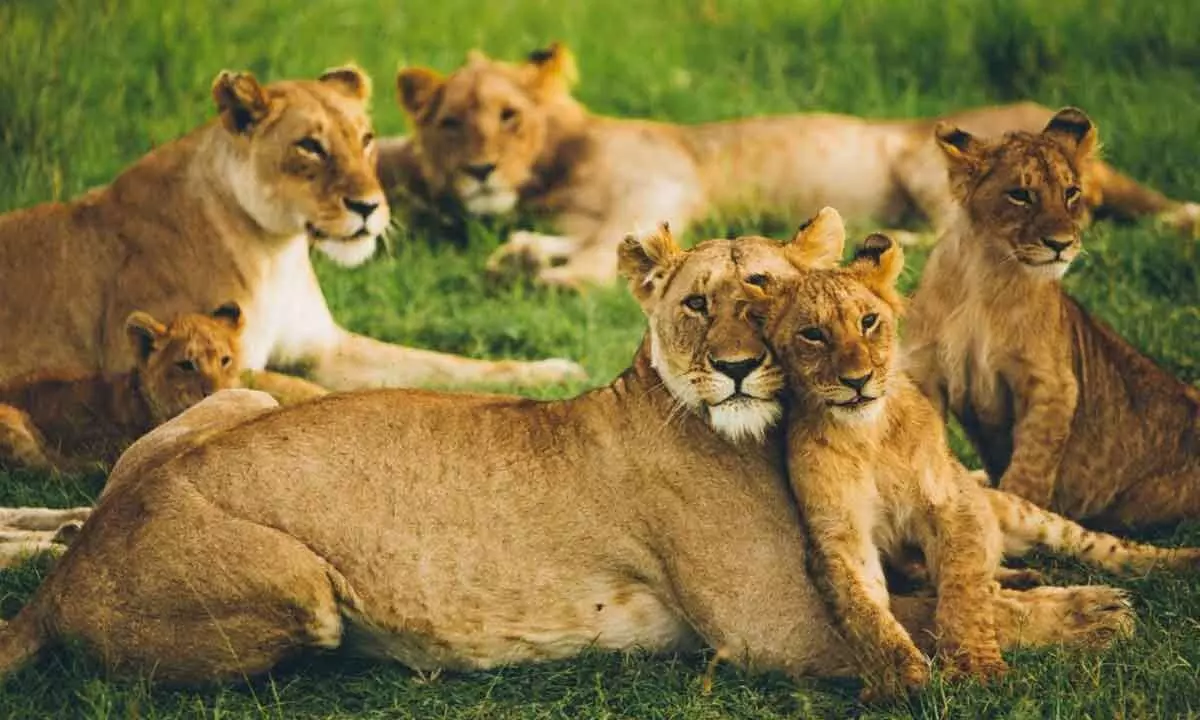World Lion Day 2022: Why Asiatic Lion Need Other Home Apart from Gujarat's Gir

The Gir Forest had around 400 lions in 2020, as per the state forest department estimate.
The major worry is Asiatic lion is only found in one place, in the world, that is Gir National park and Wildlife Sanctuary in Gujarat and its surrounding areas. The above reserve is only natural habitat for this royal beast.
Each year on 10th August, World Lion Day is celebrated, this day helps us to make aware the significance and protection of the wild beast, which is the king of the jungle.
The Royal Bengal Tiger is thriving in India, but same cannot be stated for the big cat, Asiatic Lion.
The major worry is Asiatic lion is only found in one place, in the world, that is Gir National park and Wildlife Sanctuary in Gujarat and its surrounding areas. The above reserve is only natural habitat for this royal beast.
In the year, 1913 only mere 20 lions were there in India, the significant drop was due to encroachment and hunting. The Indian Government turned the table, by putting conservation efforts very seriously and things started changing. As per the 2020 census, the lion population there had been registered an increase of 25% in the previous 5 years and now presently stood at 674.
The above majestic species is listed in endangered by the International Union for Conservation of Nature (IUCN), as it is still vulnerable to numerous threats. It does not help that lions are all restricted one reserve in Gujarat's Gir.
Outbreak of Disease
In the month of September, In 2018, 24 lions died in a matter of weeks in Gir. The canine distemper virus (CDV), a highly infectious disease was detected among the dozens of royal beasts and it killed at least 11 of them.
Nearing to 36 lions were kept under the observation out of which 21 were tested positive for CDV. 7 were discovered to have a protozoan infection, transmitted by ticks.
These lions were isolated so that they prevent the infection from widely spreading. Special vaccines were imported and each animal were given about 3 shotes followed by a booster dose.
The above outbreak in 2018, was a grim reminder that even though number of lions has been increased, their safety cannot be granted. Lions do have low genetic diversity because of their small population size, which makes them more vulnerable to epidemics.
Risk due infrastructure projects and human wildlife conflict
We find, a significant number of lions, about one-fourth of the lions tend to live outside the core habitat, thus increasing the risk to them from varied infrastructure projects, human wildlife conflict and other external factors. The Gujarat Government had stated that, around 184 lions had died during the 2016 and 2017, of which 32 of them had died due to unnatural causes, which include poaching.
Natural Disaster
There is also the threat of natural calamity. The 2015 floods in Saurashtra has submerged hundreds of villages and parts of the sanctuary, killing 8 lions.
Is the habitat enough for all lions?
No, far from it, the number of lions is presently growing but their natural habitat is also shrinking, which is a cause of concern. The Gir has become overcrowded which is leading to infighting and forcing the territorial animals to look for new territory.
More than 100 lions, which can now be found in the coastal areas of the Gujarat.
The Gir Forest had around 400 lions in 2020, as per the state forest department estimate. The rest of the Gujarat has around 275 lions, of which 104 spread themselves across the 300 kilometres of the state's coastline.
Normally, we find it would be difficult for the lions to adapt to a coastal habitat, but they tend to have no option because of the scarcity of the land stated the wildlife scholar, Dr Nishith Dhariya.
As per the forest officials, territorial wars have made lions leave Gir. They follow the Heran river, which passes through the forest and make their way to the coastline.
The forest department is also doing everything can protect the king of the jungle. They have planted deciduous gum Arabic trees, in the coastal areas, which offer them similar habitat to Gir,
What more can be done for the Asiatic Lion?
Wildlife Activists have been demanding, that few of the lions should be moved to the Kuno-Palpur Wildlife Sanctuary in Madhya PRadhesh. The plan for translocation dates back to 1993 and 1994, but little has been done in this regard.
In April, 2013, the Supreme Court has ordered Gujarat to give lions to the Madhya PRadhesh within the next six months in order to save them from possible extinction in case of any catastrophe like an epidemic, a large forest fire and also increase in the genetic pool
Gujarat has filed a review petition, followed by a curative petition, which has been dismissed in the month of October, in 2013 and August 2014, respectively. Then the state government insisted , on completing more than 30 studies before translocating lions.
Why lion population only still found in Gujarat?
The government of India has got other plans to save the king of the Jungle.
The Lion Project launched by the Prime Minister Narendra Modi on 15th August, 21020 has zeroed in on seven sites in the state of Madhya Pradhesh and Rajasthan for the relocation. By 2021, the Gujarat has prepared a fresh plan, wherin it can move the animals to state's Badra Wildlife Sanctuary and other areas. This does not include the relocation of other states.
On the 10th August, an announcement is expected that Project Lion would focus on assisted natural dispersal across Saurashtra and potentially to Rajasthan by the time India celebrates 100 years of independence in 2047.















